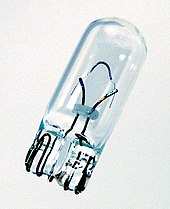
A wedge base is a type of electrical connector used as a fitting for small light bulbs. It is similar to the bi-pin connector, except that the two "pins" are the same wires that extend into the bulb (rather than being rigid), and the wires are bent up onto the sides of the base, where they make contact with the socket. The wires are usually inserted into a plastic base that the bulb is mounted in, and which is often narrower at the tip than at the bulb, giving it a wedge shape and usually ensuring a tight connection, depending on manufacturing tolerances. Some bulbs have no plastic base, and the wires are simply bent up to the sides of the bulb's glass base.
The bulb is inserted and removed with straight in or out force, without turning as with a bayonet mount or Edison screw, on certain bi-pin light sockets. For true wedges, compression is the force that holds the bulb in, while others use simple friction, or snap into a socket with spring-loaded electrical contacts that "grab" the corners or other protrusions on the base to prevent loosening from vibration. In contrast, a "slide base" (sometimes "telephone slide base") lamp also is inserted in a socket without rotation, but has two long contacts on either side of the lamp envelope connected to the lead wires.
Bulbs of this type are commonly used in automotive lighting and in low-voltage lighting used in landscape lighting. The bulb may have dual filaments, acting as both a low-wattage tail light or parking light and a higher-wattage brake light or turn signal. In this case, one has its contacts near the center of the base, and the other toward the outside edges, so that they cannot be accidentally swapped. Along with putting contacts on the opposite (alternating) sides, this gives the base rotational symmetry so that the user does not have to determine the exact position of the bulb before inserting a new one.
Wedge bases are designated with the letter W and possibly a second letter indicating the exact type (often keyed to prevent the wrong colors from being used in automobiles), the thickness in millimetres, a lowercase x, the width in millimeters, and a lowercase d to indicate a double-contact (single-filament) bulb or q for a quad-contact (dual-filament) one. Like small bi-pins, the measurement may be expressed as a decimal, such as 2.5, instead of a whole number. In the US and the automotive industry, the bases are often designated with a T designator, as in T5, T10, or T15. Alternatively, a numerical code is sometimes used, such as 921 for a W16W/T15 bulb.
In Europe, bulbs using wedge base connectors are often referred to by the designations the World Forum for Harmonization of Vehicle Regulations has assigned to them, like P27/7W for W2.5x16q when used as a combined 27 and 7 watt light bulb intended for position, brake and turn lights in vehicles.
LED bulbs are also made that will retrofit incandescents with the same base, but may affect the electrical relay that controls the blinking of turn signals, or cause others sensors to assume that a light bulb is out (see idiot light). In this type of "bulb", all of the LEDs may light regardless of which of the contacts are activated on the base, but like a dimmer or a three-way screw-in fluorescent, the brightness is changed instead by the bulb's internal electronic wiring.
Although several types of fixture-ballasted compact fluorescent bulbs (such as the common PL-13) use a large wedge-like base, they are designated as bi-pin or quad-pin bases.